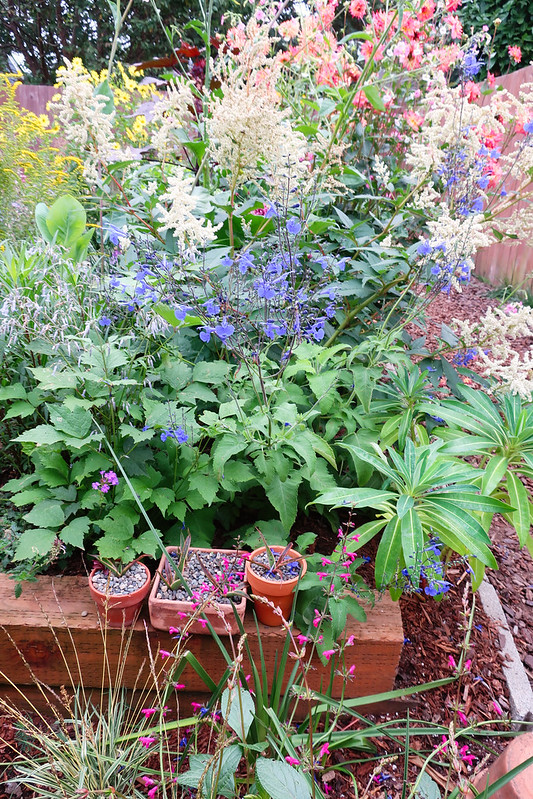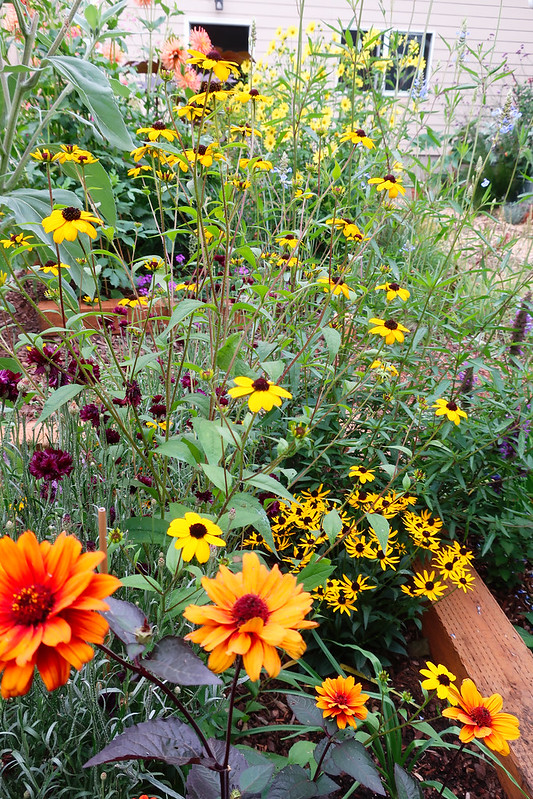I was actually hoping to do a Bloom Day post for the 15th, but photos wouldn’t load, etc. For the time being, this little becalmed boat of a blog seems to have righted itself and is wobbily under sail again, once again taking orders and allowing content posting from its captain. And content for now is all about the rude good health of the few dahlias I planted in the border made last fall of a berm of stripped turf where I expected not much to grow the first season as it settled — so why not plant a few dahlias?
It’s too early to confirm or refute personal theories, but leaping to conclusions has always been my favorite sport. I’m an inveterate leaper. And I have long suspected gardeners are cynically encouraged to follow their hearts and not their brains regarding plant choices, when many plants have a specific range of acceptable growing conditions outside of which there will be misery (for gardener and plant). You know, if you haven’t killed a plant three times, you’re not really trying, etc. (Go ahead, take a flier on this cloud forest denizen — it might just love Phoenix!) Admittedly, if we don’t experiment, nothing gained. Because, sure, there are always exceptions — Verbena bonariensis and Mexican feather grass seem to grow just about anywhere. And, sure, you can eke out a performance from dahlias even in hot summer climates if you have impeccable horticultural instincts and practices, but it’s not about just adding more water. Oh, no, it’s about night and daytime temps and latitude and proximity to coastal breezes and stuff that just can’t be faked. Of course, beating the odds can be an irresistible temptation, but I can’t think of a plant that I would move heaven and earth to grow — possibly because I’m a promiscuous generalist as far as plants are concerned. There are just so many interesting plants to consider.
And after wondering mid-summer at the light presence of pollinators, and after diligently preparing an elaborate banquet for them, clouds and swarms of them finally arrived fashionably late in September, especially to pillage pollen off of Helianthus ‘Lemon Queen’ and Solidago ‘Fireworks.’ Okay, then!
Some of my remaining questions about this first-year garden: How long does this show go on? What does a garden collapsed by frost really look like? Will my Ricinus ‘New Zealand Purple’ reseed for next year? If I leave the dahlias in the ground, as I tentatively plan to, do they have a chance in hell of returning next year after 90-something inches or rain? And if this is the result its first year, what in heaven’s name to expect of its second year?















I think that garden was just waiting for someone like you to stick a shovel in and plant! Your dahlia display borders on overwhelming, especially as I’ve coached and coddled my plants only to get miserly (if any) displays from my tubers this year. As to Verbena bonariensis, my garden may be the exception to the contention it will grow anywhere – of the several I planted this year only 2 produced modest blooms before withering away and as I’ve planted them before I’ve no reason to expect they’ve self-seeded. I laughed at your last photo as I bought 3 of the ‘Summer Sunshine’ Teucrium just before we received notice of the outdoor water ban so I kept them in pots and carefully watered them – one quickly croaked anyway.
Love your comment “I would move heaven and earth to grow any plant”. Doesn’t that just epitomize almost every avid gardener. Always wanting to push the limits of their climate. Gardening in the PNW usually requires a machete to control plant growth so expect more ‘leaping’ next season.
Well, you pose some good questions… first, how long the show will go? thats a hard one, because in my zone 8b (south sound) garden, I’ve had first frost as early as mid October, and as late as Christmas… so… take cuttings of what you may consider you can’t go without and then cross your fingers for the rest. Second, as for the dahlia’s, I’ve only lost mine twice in 20 years when left in ground for the winter but your rain is twice mine so you may want to dig them. If not, you may have the dahlia’s that ate your back yard! Or in other words, that old aphorism, it holds true and you will love it!
@Kris, when I see all the ungardened space surrounding homes in my neighborhood — I’ll just never understand it! And nobody turns on a hose here for the dry months. The lawns are unwatered (they will return with the rains), the rhodies, Japanese maples, everything goes unwatered but seems to manage to get through the dry months. I would think your raised beds in the cutting garden is the best bet to grow dahlias, but I suspect they just don’t like the 33-degree latitude sun! Away from the Oregon coast temps are as hot as SoCal, and sometimes hotter, but the sun is much stronger down south, of course. I found the teucrium at Armstrong! I think it was from Native Sons.
@Elaine, I must have blurred my meaning, because I meant to say I would not go to extremes to grow a plant, for example, meconopsis in LA! And thanks for the tip on what to expect regarding plant growth — a machete isn’t a bad idea!
@Erik, thank you sooo much for your input. I did ask the owner of Old House Dahlias about dahlias wintering in ground, and he said as a commercial grower he lifts the tubers to guarantee survival of stock for sale, but for a home gardener he definitely would leave dahlias in the ground.
Those Dahlias are just sickening. You break my heart.
Twist the knife–grow an Aloe polyphylla. Will probably be happy and gorgeous kept under the eaves, away from the rain. Twist the knife…
@Hoov, you’ll be breaking my heart soon enough, with photos of your aloes in bloom. And that’s a great idea about the spiral aloe! It might just have a chance here.